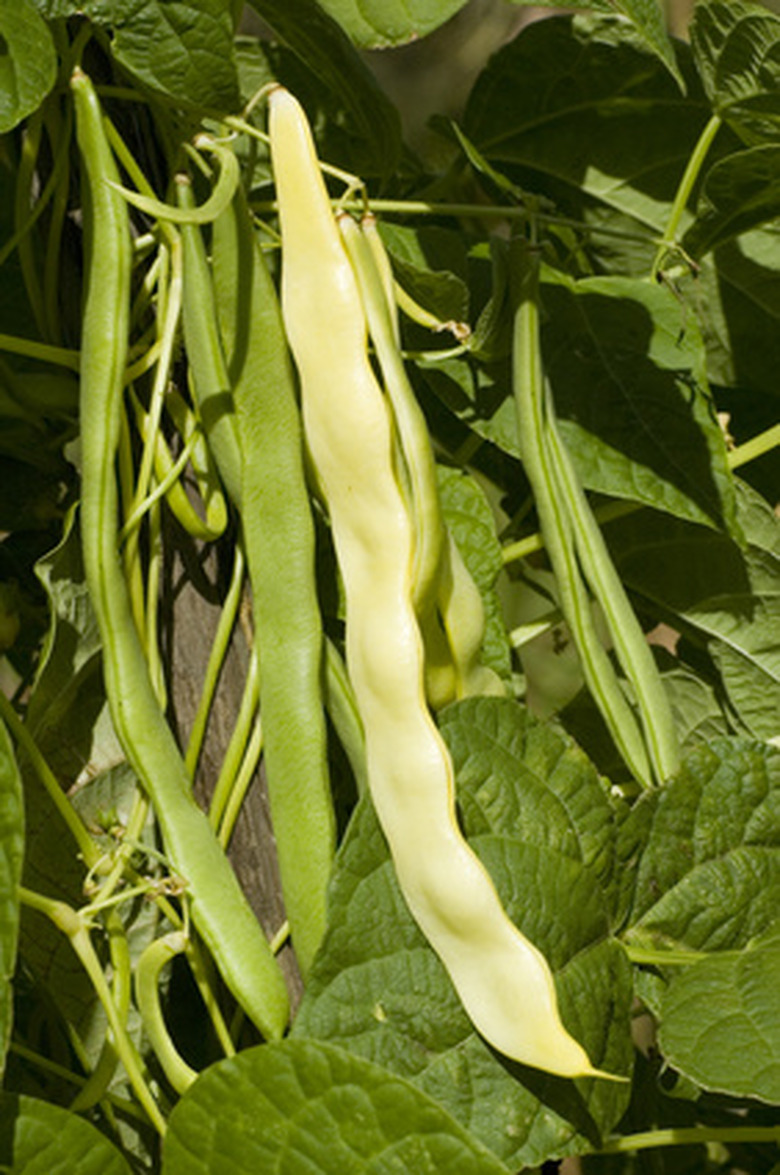Bugs That Eat Bean Plants
The bean plant is one of the most ancient crops known to man. Some type of bean can be found on every continent of the world, with the exception of Antarctica. Beans are a top choice of gardeners everywhere.They are fast-growing and adapt to most climates and soil conditions. Bean plants are susceptible to a wide variety of pests but are hardy enough to withstand an infestation and still yield a normal crop.
Bean Leaf Beetle (Cerotoma trifurcata)
Found on string beans, soybeans and dry beans, bean leaf beetles are oval shaped, 1/4-inch long and have a distinctive triangle-shaped marking above their wings. They are either yellow-green or red in color and often have black spots on their wings. Bean leaf beetles chew 1/8-inch holes in the leaves of younger plants. A high population of adult bean leaf beetles will cause defoliation of the first leaves and will kill the young plant. Adults will also feed on the pods but do little damage to the bean. Control beetles by hand picking them if infestation is small; if it's widespread you may want to use chemicals, such as permethrin or carbaryl to rid your garden of these pests.
- The bean plant is one of the most ancient crops known to man.
- Found on string beans, soybeans and dry beans, bean leaf beetles are oval shaped, 1/4-inch long and have a distinctive triangle-shaped marking above their wings.
Bean Aphids (Aphis fabae)
Dark green to blue-black in color, the bean aphid is about 1/12 of an inch long and can be winged or wingless. Bean aphids are common to all varieties of the bean plant. They have soft, pear-shaped bodies and white appendages. Aphids feed in colonies and cause curling, yellowing and deformation of the plant leaves by sucking the sap from the leaves. They leave behind a waste product called honeydew that is a black, sooty mold like growth. Aphids are known to transmit viruses like common bean mosaic to plants. Bean aphids can be hand removed from plants, but insecticidal soaps are more successful in ridding plants of bean aphids.
- Dark green to blue-black in color, the bean aphid is about 1/12 of an inch long and can be winged or wingless.
- Aphids feed in colonies and cause curling, yellowing and deformation of the plant leaves by sucking the sap from the leaves.
Bean Thrips (Frankliniella occidentalis)
The adult bean thrip is a cigar-shaped insect that is amber, black or yellow in color and has spots on its wings. Thrips are sometimes difficult to spot with the naked eye and are about the size of a flea. All bean plants are susceptible to an attack by bean thrips. These pests feed on younger seedlings by eating the leaves and the flowers. Signs of heavy thrip infestation are ragged looking plants and distorted leaves that are brown and curve upward at the edges. Usually plants can outgrow the problem and will yield a healthy crop. Proper use of chemicals will control thrips; sometimes unfavorable weather conditions also help eliminate bean thrips.
- The adult bean thrip is a cigar-shaped insect that is amber, black or yellow in color and has spots on its wings.
- All bean plants are susceptible to an attack by bean thrips.
Stink Bugs (Halyomorpha halys)
Both green and brown stink bugs attack every kind of bean plant. Green stink bugs are bright green in color and have black bands on their antennae. Brown stink bugs have a yellow to light green underside and are brown on top. Both are shaped like a shield and are about 1/2-inch long. They do damage to plants by attacking the seeds and pods of the plant. They will also feed on the stems, leaves and flowers. Signs of feeding include black or brown spots on plants. Young seeds may be deformed and undersized, or even aborted. Older seeds will be discolored. Stink bugs can be controlled by natural predators, such as wasps, or with the proper use of insecticide.
- Both green and brown stink bugs attack every kind of bean plant.
- Brown stink bugs have a yellow to light green underside and are brown on top.
